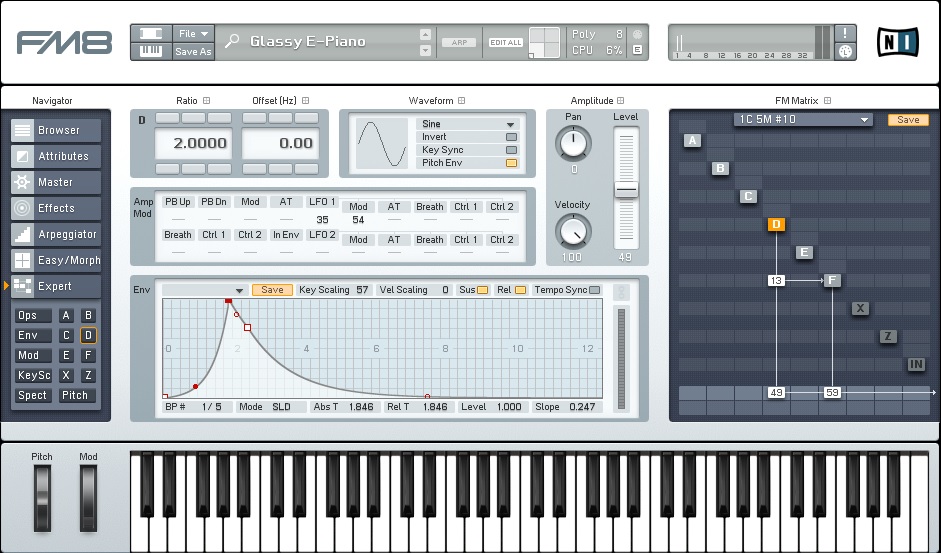FM synths aren’t only for “adult contemporary” music – find out how to make them rock
When FM synths came on the scene in the mid ’80s, their bright, digital sound stood in stark contrast to their analog ancestors. Analog recording still reigned, and the DX7’s clarity complemented the warmth of analog tape. It’s interesting that the dominance of FM synthesis ended around the same time that digital audio recording became commonplace; perhaps digital+digital was just too much. Maybe it’s also not a coincidence that analog synths made a comeback as the crossfade into digital recording occurred.
But digital audio has come a long way, and today’s audio quality is a lot sweeter than it was 30+ years ago. If you’re getting back into FM, or re-discovering its joys for the first time, here are some tips on how to get some sounds that are super-friendly for rock. Don’t have an FM synth? Maybe you do…we’ll also cover some popular soft synths that have enough FM capabilities to get you started.
ADD SPACE AND AMBIANCE
FM synthesis was very popular in “new age” type recordings, often providing bell and Rhodes-type sounds in a track with acoustic guitar, percussion, etc. However, when recorded direct with instruments that had room ambience — even trace amounts — it sounded somehow “wrong” because its ambiance didn’t match up. Even with reverb added, the FM synth would still have a different quality.
I usually use a dedicated reverb to add a tiny bit of room ambiance to an FM synth, even if it’s going to feed reverb through an aux bus. The emulated “room sound” helps the synth blend in better with acoustic tracks (or samples that were recorded with room ambiance). Try these reverb settings as a starting point: 300-500 ms decay time, small room size, low diffusion for relatively sustained sounds (e.g., 10-20%), and no pre-delay. If you find a good room ambiance sound, save it as a preset — you may want to use it on other synth sounds that are recorded direct.
CREATIVE DISTORTION
Want a really cutting “lead guitar” sound that won’t just jump out of a track, but make guitar players jealous? FM’s basic sound generator is the sine wave, which just happens to distort beautifully. This is because it has very few harmonics, so adding distortion doesn’t create those screeching highs that normally make listeners dive for their earplugs.
However, sine waves by themselves are b-o-r-i-n-g, so most FM synth patches add more operators to produce a more complex, interesting sound. We don’t want that.

The featured image at the top of the page shows a basic fun-with-distortion patch for the FM8, but for nostalgia fans, Fig. 1 is from the original FM7 software – it works the same way. I stripped the Glassy E-Piano preset down to two operators, D and F (of course, you could use any two operators). F is set to a frequency ratio of 1.0000, and D to 2.000. D’s output modulates operator F and also feeds the audio output (the latter is optional), but note that it uses an amplitude envelope to fade in over about 2 seconds. Both operators also receive a little LFO to simulate a guitar’s finger vibrato, controlled via mod wheel.
When you press a key, operator F supplies the fundamental. Then the “feedback” octave higher component from operator D fades in over time — tasty! For an even cooler effect, bring up the “Analog” parameter to about 30 or so. This provides the random detuning effect introduced in the DX7 II family, and adds more animation to the sound (and also makes it sound more like guitar, because a guitar’s strings are never perfectly in tune).
The output then goes through the distortion plug-in of your choice. I favor multiband distortion devices like Steinberg’s Quadrafuzz and MOTU’s Multifuzz (both designs are based on my original hardware Quadrafuzz), iZotope Trash, and of course, my Helix Multiband presets, which is pretty much all I use these days.
INTERESTING PANNING OPTIONS
FM synths usually offer interesting panning options. For example, the FM8 can pan each operator output anywhere in the stereo field. In hardware-land, Yamaha’s TX81Z can pan notes in the stereo field based on note value (e.g., lower notes show up on the left, and higher notes on the right), velocity, or LFO frequency. These options help create more interesting stereo imaging.
YOUR SECRET FM SYNTH
Want to experiment with FM? You may already have some soft synths with FM capabilities. Usually this involves dual-oscillator architectures, where the output of one oscillator (the modulator) modulates the other oscillator (the carrier). You generally listen to the carrier output, and control the modulator’s level via envelope, mod wheel, etc. to adjust the amount of the FM effect. Synths I’ve used that allow for at least some form of FM include the Arturia Moog Modular V, rgc:audio z3ta+, Cakewalk PSYNE, Audio Simulation DreamStation DXi2, and the Green Oak Crystal).
So what are you waiting for? Check it out!
